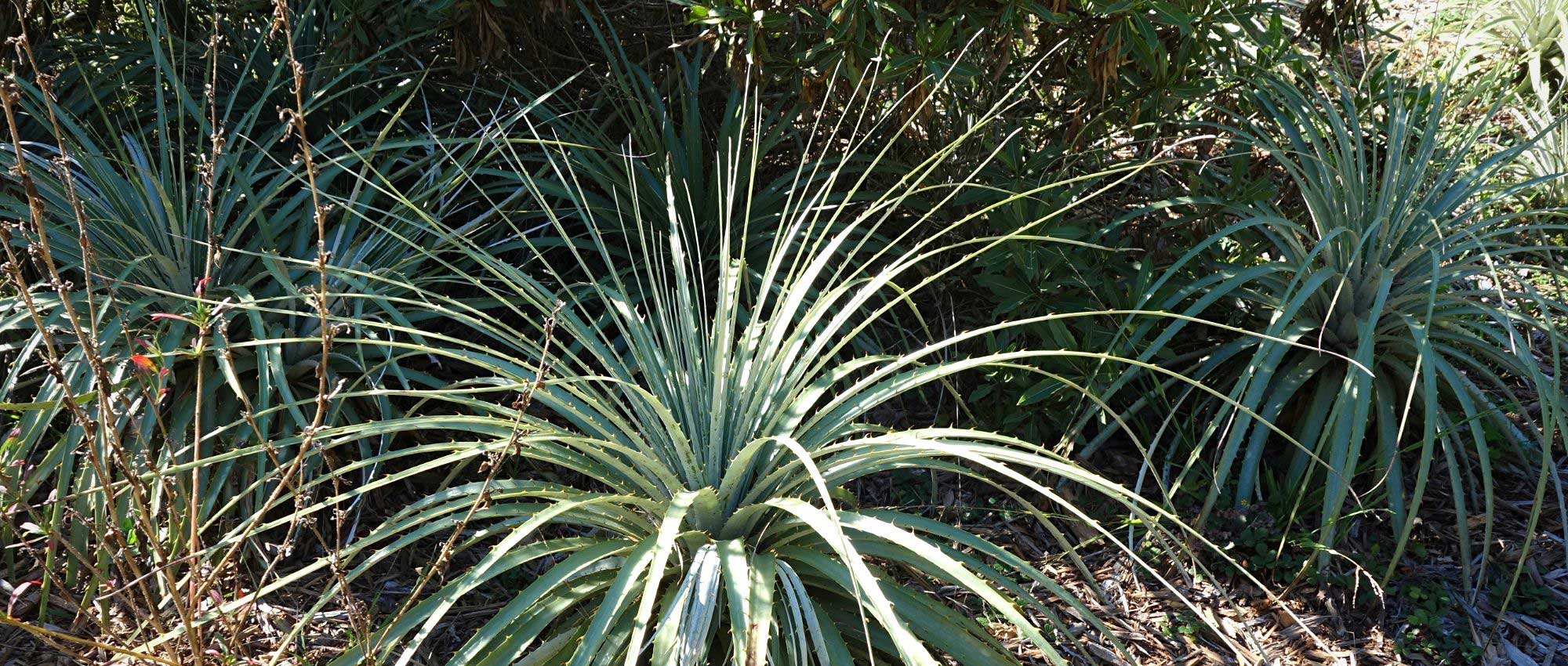
Puya: planting, growing, and maintaining
Contents
Puya in a nutshell
- Puya are uncommon plants, rarely cultivated in gardens
- They produce impressive inflorescences in summer, sometimes very large
- Some species have turquoise or metallic blue flowers, a very rare hue in the vegetable kingdom!
- Puya are appreciated for their very exotic style!
- They form beautiful rosettes of long, slender leaves, usually thorny
- Their cultivation in open ground is reserved for the mildest regions: Mediterranean basin, Breton coast…
- They need to be grown in full sun, in well-draining soil
A word from our expert
Puya are surprising plants that are rarely seen in gardens. Native to the mountainous regions of South America, these relatives of the pineapple form large clumps of rosette leaves, very fine and elongated, in shades of green, blue, or silver. In summer, they produce immense floral spikes, which vary in often surprising hues depending on the species. The most impressive is undoubtedly Puya berteroniana with its sapphire blue flowers, but the yellow flowers of Puya chilensis and the unique blue and red inflorescences of Puya venusta are also appreciated.
Puya require a warm, sunny location and well-draining soil, as they grow naturally on rocky slopes in poor, arid soils. They are drought-resistant. They are perfect for rock gardens, for example, alongside agaves, Aloe aristata, Opuntia, Echium pininana, and Mediterranean plants. Puya are not very hardy: depending on the species, they can tolerate temperatures down to -5 °C, or even -10 °C, in dry soil. Outside the Mediterranean basin or the Breton coast, cultivate them in pots and bring them into a greenhouse or conservatory for the winter.
Botany
Botanical data
- Latin name Puya sp.
- Family Bromeliaceae
- Common name Puya, Chagual, Sheep-eating plant
- Flowering often in late spring or summer, between May and July
- Height generally between 60 cm and 2 m, sometimes up to 5 m tall
- Exposure full sun
- Soil type perfectly drained
- Hardiness -5 °C, even -10 °C
Puyas comprise 227 species of perennial plants with evergreen foliage. Most of them originate from the mountainous and arid regions of South America (Argentina, Bolivia, Chile…). They are notably found in the Andes, where they grow up to 2,000 metres in altitude… and even higher: Puya raimondii can be found between 3,200 and 4,800 metres. They are primarily located on rocky and arid slopes.
Puyas are Bromeliaceae, belonging to the same family as pineapples! Most Bromeliaceae are epiphytic: they grow on tree trunks or rocky surfaces, but this is not the case for Puyas, which are terrestrial. There are also cultivated Bromeliaceae as houseplants: these include Tillandsia, Vriesea, Aechmea, Billbergia, and Guzmania. The Puya is among the hardiest Bromeliaceae, alongside Fascicularia, which can also be planted outdoors in regions with mild climates.
Puyas are xerophytic plants, adapted to drought. Their fine, thick leaves, arranged in rosettes, help limit water loss, and their sometimes silvery-grey colour reflects sunlight and protects them from heat. Puyas are robust and sturdy due to their natural origin, but not very hardy. They can withstand temperatures down to -5 °C, and even -10 °C for the hardiest varieties. They are best suited for Mediterranean or Breton gardens, where the risk of frost is very low. In colder regions, it is advisable to grow them in pots and bring them indoors for the winter. However, when the foliage freezes, Puyas can sometimes regrow from the stump.
The Puya is nicknamed “Sheep-eating plant” because sometimes sheep wool gets caught in the thorns of the foliage, trapping the animal, which eventually dies of exhaustion. As it decomposes, the sheep enriches the soil at the base of the Puya, providing it with nutrients… making it a protocarnivorous plant! This nickname particularly refers to the species Puya chilensis.

The foliage of Puya venusta, Puya chilensis, and Puya mirabilis (photos Megan Hansen / Mokkie / Marija Gajić)
Depending on the species, Puyas generally measure between 30 cm and 2 metres in height. Some are quite small, like Puya grafii, which is mainly grown indoors! The tallest is Puya raimondii: it can reach up to 3 metres tall in vegetation, and up to 9-10 metres when in bloom! It is indeed the largest bromeliad in the world. The shape of Puyas can also vary: some are very spreading (Puya mirabilis, Puya coerulea…) while others are upright (Puya raimondii…).
Puyas tend to grow larger in their native habitat than when cultivated in France in open ground. When in pots, their dimensions are even more limited.
Puyas form a rounded rosette made up of fine, long leaves, a very characteristic shape of the Bromeliaceae family! They are tough, thick, and edged with thorns along the leaf margin. Depending on the species, the leaves can be green, sometimes bluish, or silvery-grey. The leaves of Puyas somewhat resemble those of Agaves or Aloes, but are much narrower. Even when not in bloom, the Puya is very decorative due to its foliage. The foliage of the Puya is evergreen, remaining in place all year round.
It takes several years before the plant begins to flower. Puyas generally bloom in summer, around June-July, and their flowering is often spectacular! They form large, upright floral spikes, quite dense, usually measuring between 70 cm and 1.5 m in height and can gather hundreds of flowers! The most impressive in this regard is Puya raimondii, as its inflorescence can reach up to 9 metres long and contain 20,000 flowers (however, its flowering is rarely observed as it takes between 70 and 100 years to bloom!) Generally, the floral stem of Puyas is solid and very thick.

The flowers of Puya coerulea var. violacea, Puya berteroniana, and Puya mirabilis (photos Yastay / Natasha de Vere & Col Ford / Forest and Kim Starr)
The flowers are trumpet or bell-shaped, generally measuring 3 to 5 cm long. Some species, like Puya berteroniana or Puya alpestris, have surprising sapphire blue or metallic blue flowers… a very rare hue in the plant kingdom! The yellow flowers of Puya chilensis are also appreciated, while other species have white flowers (like Puya weberbaueri) or green, and even almost black, like in Puya coerulea var. monteroana! In Puya venusta, the red floral stems bear blue flowers, creating an impressive contrast. Thus, Puyas offer blooms in rather original shades!
The inflorescences of some species, like Puya chilensis, bear horizontal branches, sterile ramifications, which in nature serve as perches for hummingbirds that come to pollinate the flowers.

The large inflorescences of Puya berteroniana, Puya chilensis, and Puya venusta (photos Rod Waddington / Mar del Sur / Vahe Martirosyan)
Puyas generally take several years before they start to flower. For Puya chilensis, for example, you have to wait 6 or 7 years. Most often, Puyas are monocarpic, similar to agaves: they die after flowering. The plant expends so much energy producing such a large spike of flowers that it does not survive… however, it will generally have had time to produce offsets that will take over!
Read also
10 hardy plants for an exotic dry gardenThe main varieties of Puya
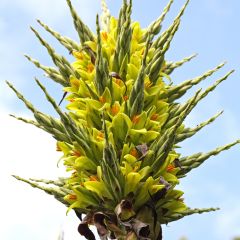
Puya chilensis
- Flowering time July
- Height at maturity 1,75 m
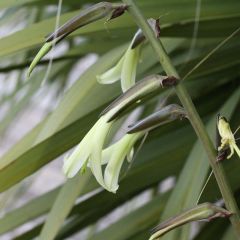
Purple Calabash Organic Tomato - Ferme de Sainte Marthe seeds
- Flowering time July
- Height at maturity 80 cm
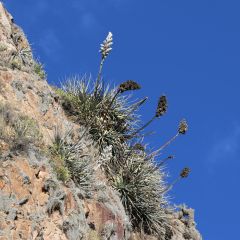
Puya weberbaueri
- Flowering time June, July
- Height at maturity 80 cm
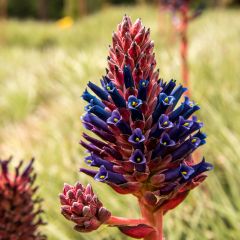
Puya venusta
- Flowering time May to July
- Height at maturity 35 cm
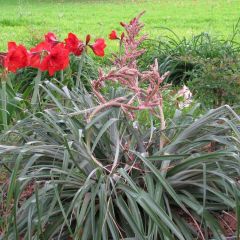
Puya assurgens
- Flowering time July, August
- Height at maturity 55 cm
Discover other Puya
View all →Available in 1 sizes
Available in 1 sizes
Available in 2 sizes
Available in 1 sizes
Available in 1 sizes
Available in 1 sizes
Available in 1 sizes
Available in 1 sizes
Available in 1 sizes
Available in 1 sizes
Planting
Where to Plant?
Puya is a plant that requires warmth and dislikes stagnant moisture: plant it in full sun, in very well-drained soil. You may consider placing it on a mound or raised rockery to allow moisture to drain quickly. In any case, choose a location sheltered from cold winds. Puya is ideal for rockeries, alongside agaves, aloes, Opuntias, Cordylines…
Avoid placing Puya near high-traffic areas, at the edge of paths, in front of the house or terrace… the thorns on the edge of the lamina can be quite dangerous. Additionally, some Puyas can grow very large (for example, Puya chilensis): ensure there is enough space around them.
Outside the Mediterranean region and the Breton coast, it is better to grow Puya in pots and bring it indoors in winter to protect it from the cold! Choose reasonably sized species (Puya mirabilis, Puya assurgens…) and avoid the larger ones. Place your Puya on the terrace in spring, as soon as there is no longer a risk of frost, in a sunny spot. In autumn, bring it under cover, preferably in a greenhouse or conservatory, or possibly in the house behind a window.
When to Plant?
Plant Puya in the ground in spring, from May, or even in June, when temperatures have warmed sufficiently and there is no longer a risk of frost.
How to Plant?
Remember to wear gloves when handling a Puya plant to protect yourself from the thorns that line the leaves.
In the Ground:
- Choose a well-sunny location, possibly on a mound or rockery, then dig a planting hole about three times the size of the root ball.
- Feel free to mix gravel or coarse sand into the soil to improve drainage.
- Gently remove the Puya from its pot and plant it.
- Replace some soil around it to fill the hole, then firm it down.
- Water.
In a Pot:
- Take a pot with drainage holes at the bottom.
- Place a layer of gravel or clay balls at the bottom for drainage.
- Then add a draining substrate to the pot, such as a mix of potting soil, coarse sand, and coconut fibres.
- Plant your Puya, gently positioning it in the centre of the pot.
- Add substrate all around.
- Water.
- Place it outside in full sun, or indoors, for example in a conservatory or greenhouse.
If you are growing it in a pot and placing it indoors, position it where it can receive maximum light!
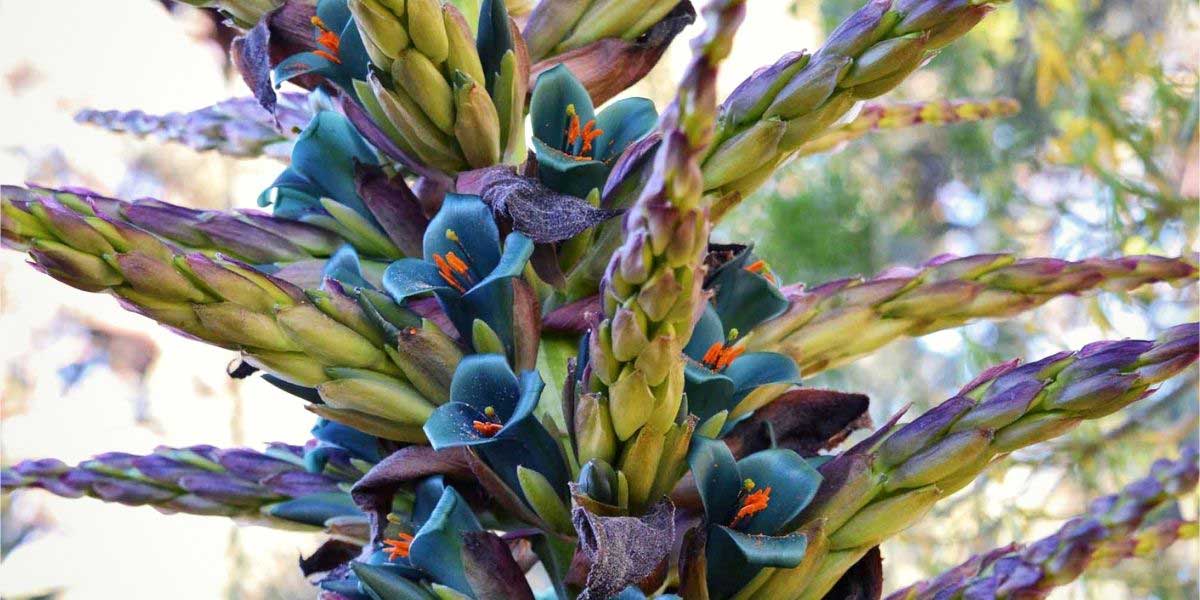
The flowering of Puya berteroniana (photo Rod Waddington)
Entretien
In open ground, you can water a little during the first year to encourage its rooting, but afterwards, the Puya should not require watering. It is a xerophytic plant, highly resistant to drought.
If your Puya is planted in open ground outdoors, you can protect it from the cold by installing fleece or by placing a good layer of mulch around the stump. Even if you live in a region with a rather mild climate, the Puya is still a bit more fragile in the first few years, so don’t hesitate to provide protection. You may also consider setting up a small structure above the Puya to shelter it from rain, as it is sensitive to winter moisture!
If you are growing Puya in a pot and live in a region with a mild climate, you can leave it outdoors all year round. In other regions, it’s best to bring it indoors in autumn and take it out again in spring. Place it in a spot where it will receive excellent light! Ideally, this would be a conservatory or greenhouse. Otherwise, inside the house, behind a window.
In a pot, feel free to water it a little in spring and summer, about once a week when it’s not raining. Reduce watering in winter to once a month. You can also provide a little liquid fertiliser low in nitrogen in spring and summer (for example, use orchid fertiliser). Be careful to dilute it sufficiently and not to overdo it, as Puyas naturally grow in rather poor soils and are content with few minerals.
The Puya is not very sensitive to diseases and pests, but it can sometimes be attacked by mealybugs when grown indoors, in a greenhouse, or conservatory. The main issue you may encounter with Puya is excess moisture, which can cause its roots to rot.
Multiplication
Puyas can be multiplied by taking offsets (the simplest solution) or by sowing seeds.
Sowing
Seeds should be sown as soon as they are ripe, as they do not remain viable for long (one to two months at most).
- Take small pots or a seed tray with drainage holes, and fill them with a draining substrate, such as cactus compost, or make a mix of compost and coarse sand or perlite.
- Firm it down slightly and level the surface.
- Sow the seeds by scattering them on the surface.
- Cover with a very thin layer of sifted compost, no more than 1 cm thick. The seeds need light to germinate.
- Water gently.
- Place the pot in a sheltered spot, in a bright location without direct sunlight, ideally at a temperature of 20 to 25 °C.
- Keep the substrate slightly moist until germination, watering occasionally without overdoing it.
- You can transplant the young plants into individual pots as soon as they form a small rosette and are large enough to handle.
Puyas are quite slow to germinate (between 3 weeks and 2 months).
Taking Offsets
If you are lucky enough to have a well-developed Puya, it may have formed offsets next to the original rosette. This makes it easy to multiply in this way. Some species produce offsets more readily than others: Puya mirabilis, Puya coerulea… However, you will need to wait several years for them to start producing offsets.
Act in spring, outside of frost periods, and remember to wear gloves to protect yourself from the thorns.
- Identify one or more well-developed offsets on a plant that is several years old.
- Use a spade to gently lift the offset.
- Separate it from the mother plant using pruning shears.
- Replant it in a pot with a draining substrate.
- Water.
- Place the pot in a sheltered, bright location.
Association
Puya is perfect for an exotic-style garden! It pairs wonderfully with Viper’s Bugloss (for example, Echium pininana), Opuntias, Agaves, Aloes, Kniphofias, Yuccas, Cordylines, Dasylirion… Feel free to plant them together in a large sunny rockery. You can also combine it with Fascicularia, an original and very graphic plant that belongs to the same family as Puya! Also discover Mangave: a type of small agave that offers impressive colours. Puya goes very well with the orange flower spikes of Kniphofias. You can also enjoy the flowering of Hesperaloe parviflora, Protea, Eucomis, Crocosmia, Carpobrotus…
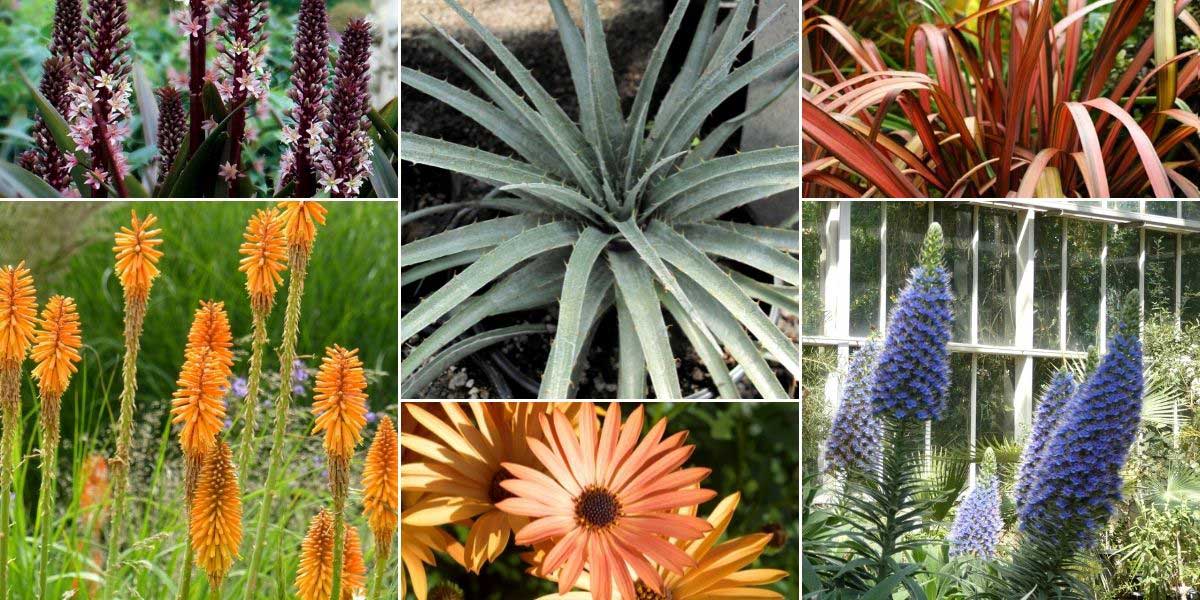
Puya integrates easily into an exotic-style garden! Eucomis ‘Sparkling Rosy’, Puya venusta (photo Megan Hansen), Phormium ‘Pink Panther’, Kniphofia ‘Fiery Fred’, Osteospermum ‘Cape Daisy Terracotta’ and Echium pininana (photo Linda De Volder)
You can create a very exotic decor around a terrace, with plants that you will grow in large pots. Consider succulents such as sedums, echeveria, and houseleeks… For flowering, enjoy the stunning Gloriosa superba, Aloe striatula, and Strelitzia reginae. You can grow these plants in large pots on your terrace and bring them indoors for winter. Also think about Cylindropuntia imbricata, a hardy cactus that can be planted in the ground as it withstands temperatures down to -15 °C, and Opuntias. Aloe striatula, Beschorneria yuccoides, and Agave mediopicta Alba tolerate -10 °C, while Dasylirion wheelerii can withstand up to -20 °C! You can also incorporate plants typical of Mediterranean gardens, such as lavenders, cistus, Euphorbia characias, Euphorbia myrsinites, Echinops, Eryngiums, and helianthemums…
For more ideas on plants to install alongside Puya, check out our advice sheet “10 hardy plants for an exotic dry garden”
Useful resources
- Discover our range of Puya!
- Our advice sheet: “Mediterranean Garden: 10 Iconic Plants to Landscape It”
- Discover our page Inspiration for Dry Terrain
- Subscribe!
- Contents


































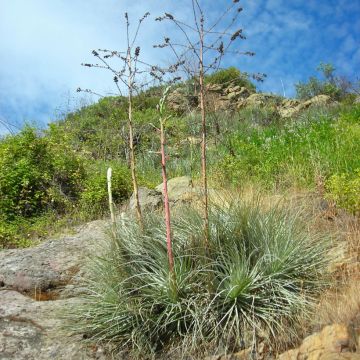
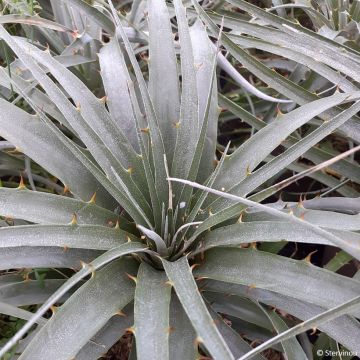
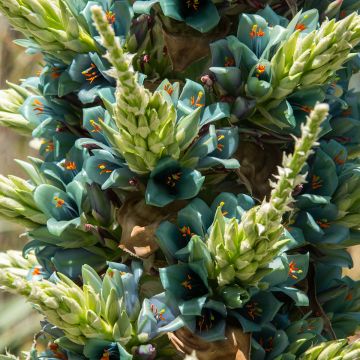
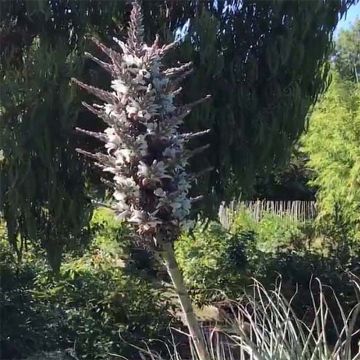
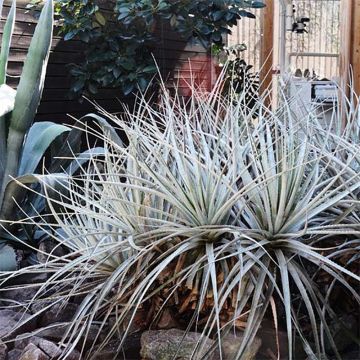
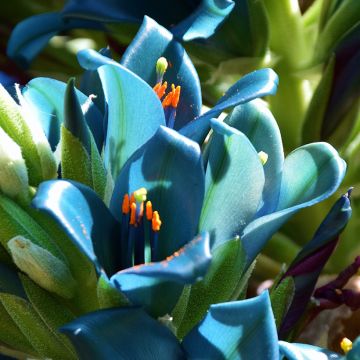

Comments